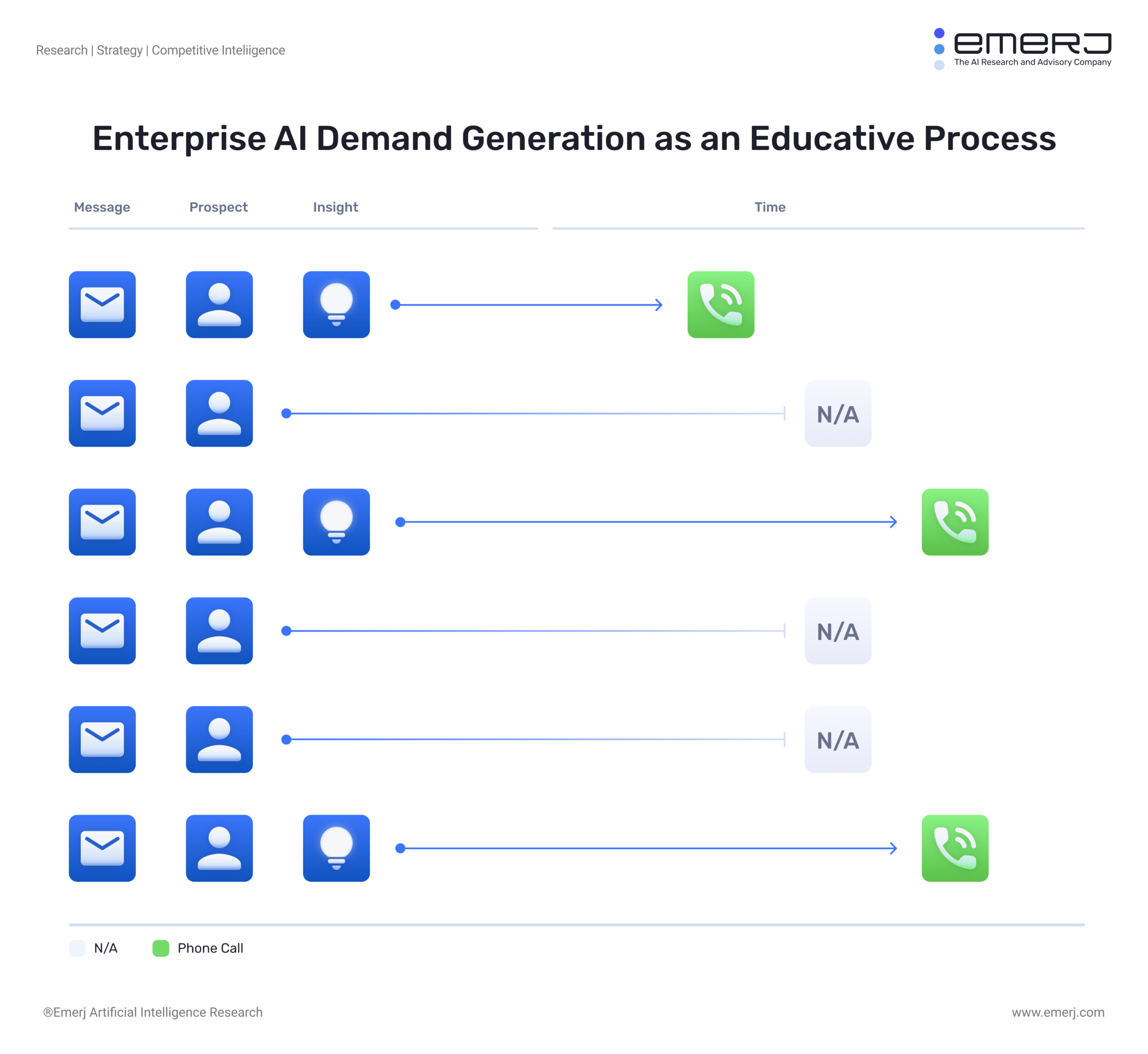Since the onset of the COVID-19 pandemic, the world has witnessed a remarkable boom in venture capital investment in AI. According to the EY CEO Outlook Global Report published last year, there has been a continued focus on and investment in AI across the global economy, with 2021 being a record year for M&A and corporate venture capital and with higher-than-average growth in R&D and capex spending.
Companies across various industries have recognized the potential of AI to revolutionize their operations and drive growth. While some of this funding has been dedicated to research and product development, increasing numbers of enterprises are now venturing into the market, actively selling their AI services.
However, despite AI’s tremendous progress in large-scale deployments, companies need help with effectively marketing and selling their AI products. Venture capital pouring into the AI sector has fueled a flurry of activity, with organizations racing to develop cutting-edge algorithms and groundbreaking technologies. While these advancements are undoubtedly impressive, they often overshadow the essential element of needing to educate customers on their potential. The challenge lies in bridging the gap between the complexities of AI technology and the business needs of potential buyers.
This article is based on insights from the hundreds of campaigns that our organization has conducted across industries and geographies for our work with Emerj Media Services and advises executives preparing to go to market with a new enterprise AI service product in the following areas:
- The pivotal role of education and market messaging in cultivating a robust pipeline for enterprise AI products.
- A comprehensive review of successful messaging strategies for marketing and selling enterprise AI products.
Don’t Sell AI Like IT
AI is distinct from traditional IT in several ways. One fundamental difference includes the expectations and mindset required for AI adoption. Many companies approach AI projects with the exact expectations as IT projects, but unlike IT, AI is not just a new set of tools—it represents a new way of working.
While IT is deterministic as a discipline, following predefined rules, AI is probabilistic, requiring experimentation and iteration to achieve desired results. The difference often leads to a lack of understanding and unrealistic expectations from stakeholders, resulting in disappointment and project failures. Understanding and acknowledging AI’s unique nature in this area is essential for successful adoption and integration.
Another significant distinction lies in the areas of data and talent. The Qatar University research paper “Re-Thinking Data Strategy and Integration for Artificial Intelligence: Concepts, Opportunities, and Challenges,” published in the journal Applied Sciences, provides a verifiable yet brief summary of how accessing and formatting data for AI systems can be challenging. The writers emphasize these challenges include:
- Poor data quality that can lead to inaccurate or biased AI models, thereby creating severe consequences, especially in areas like healthcare and finance.
- Insufficient data results in models being too simplistic, hence the inability to accurately predict real-world outcomes.
- Lack of data diversity may lead to biased models that do not represent the target population accurately.
Data scientists are vital for evaluating AI initiatives for these potential issues, setting up data infrastructure and fine-tuning algorithms. However, hiring and retaining such talent can be expensive and requires providing them with meaningful and valuable projects. Furthermore, AI projects require ongoing iteration and calibration. Unlike traditional IT projects, AI systems involve continuous testing, tweaking, and refinement to achieve human-level or acceptable performance.
There are other critical differences between AI and IT, enabling them to set realistic expectations and navigate the unique challenges of AI adoption. The most fundamental difference is that AI requires:
- Data considerations,
- Talent acquisition
- Effective collaboration
- Focus on continuous iteration for successful integration into existing business processes.
Revealing Unforeseen Solutions with AI
One of the remarkable aspects of AI technology is its ability to solve problems in previously unimaginable ways. AI solutions can automate processes that were never considered for automation, streamline operations beyond conventional approaches and significantly enhance efficiency.
The challenge here lies in the fact that buyers may not even be aware that such solutions exist. They may need to realize that their existing workflows can be optimized or that AI can make specific tasks more efficient. In turn, vendors often make the mistake of fixating on the technical aspects and capabilities of their technology, highlighting their algorithms or proprietary methodologies.
However, buyers are primarily interested in the outcomes, or how the AI solution can resolve their pain points and deliver tangible results. Vendors need to shift their focus from discussing their technology’s “what” and “how” to focusing on the business problems they can solve. By emphasizing the value of resolving these issues, vendors can captivate buyers and help them envision the possibilities offered by AI.
This division between how data scientists and customers think about technological problems and solutions is exemplified famously in an exchange between the late Steve Jobs, then returning to his post as Apple CEO after years of exile, and a disgruntled developer at the 1997 Apple Developers Conference. Often, the video is shared in business circles as a way of teaching executives how to stay positive in the face of crushing criticism (on YouTube, iterations of the exchange are often labeled — as below — “Steve Jobs Insult Response”). Yet considering the substance of their exchange, it’s easy to draw a direct line to the problems technology-focused vendors have in selling their products today.
The video runs approximately 5 minutes and Jobs’s response begins at the 41-second mark:
Nearly 27 years later, data scientists are still learning the essential lessons Jobs noted he had “the scars to prove” in his response: customers don’t care about the latest and greatest tech capabilities. No one using OpenDoc in 1997 cared if Java was an objectively superior technology. They cared that OpenDoc solved the problems they faced in their daily tasks faster than Java, and the rest is history.
AI as an Educative Sale
Still, selling AI products requires an approach that involves some degree of educating your customers. Unlike conventional products, where features, pricing and specifications are enough to make a sale, AI solutions demand a different strategy. Instead, vendors need to demonstrate how their AI solution addresses the customer’s specific pain points, outperforming existing alternatives. Buyers must be able to connect the dots, visualizing how the AI solution can alleviate their challenges. Once the “light bulb” moment goes off in the mind of the customer and they connect their daily problems with the capabilities of an AI product, the seller of that product is far more likely to win market share:
Successful AI companies master the art of educating their customers, leading with content that sheds light on buyers’ problems and provides compelling solutions. They understand that, ultimately, education plays a pivotal role throughout the marketing and sales journey. They know once they understand their customers’ pain points, vendors must effectively turn the tables of the conversation to communicate the ROI potential of their AI products, emphasizing how the technology can reduce costs, enhance efficiency and unlock new opportunities.
Fundamentally, successful AI vendors know they cannot begin the conversation with ROI potential and capabilities — only through aligning their marketing efforts with buyers’ needs and concerns first can vendors lay a solid foundation for successful sales conversions.
The two-tiered educative strategy should permeate all aspects of market messaging, from initial engagement to ongoing communication. Vendors should craft content that provides valuable insights and thought leadership, tailoring content to specific prospect types, effectively addressing their pain points and demonstrating why their specific AI solution is tailored to match their problems.
AI vendors can also differentiate themselves in the market by fully embracing the educative sale. Such an approach transcends product-centric sales and aims to empower buyers with knowledge, enabling them to make informed decisions and envision AI’s positive impact on their organizations. By turning on those “light bulbs” and guiding buyers through an educational journey, vendors can build trust, establish themselves as industry leaders, and drive sustainable growth in the enterprise AI space.
Differentiating Good and Bad Market Messaging
Bad market messaging often centers around positioning topics and themes. Vendors focus on what sets them apart— such as unique features, technological advancements or proprietary algorithms. While these aspects may be relevant in later stages of the sales process, leading with them as a primary message fails to resonate with buyers.
Buyers are not interested in abstract technological details; they wake up every morning with problems that need solutions. Messaging that solely revolves around the product’s features without addressing real-world business challenges lacks educational value. Vendors must avoid positioning-oriented topics and themes and shift their focus to attention-oriented messages that address buyers’ immediate concerns.
Effective market messaging leads with attention-oriented topics and themes. It delves into buyers’ specific problems and demonstrates how the AI solution can address these pain points. Once that connection is established, such messaging should also emphasize the return on investment (ROI) potential and the measurable impact the AI solution can have on the buyer’s business outcomes.
To achieve the transition therein, vendors must first define their target audience. Attempting to sell to a broad audience without clearly understanding their needs and concerns leads to wasted resources and ineffective messaging. By identifying specific prospect types, such as job titles, geographies or company sizes, vendors can tailor their messaging to resonate with each group. Furthermore, market messaging should prioritize the business leaders responsible for crucial outcomes, as they hold the decision-making power. Engaging with them — rather than focusing solely on technical discussions with data scientists — is critical to driving successful sales.
Focusing on the Right Prospects
Companies that need a clearer understanding of their target market should spend their valuable resources on focusing on the right individuals or groups within the organization, with the intent of finding true decision-makers. Engaging with data scientists or tech enthusiasts might seem appealing, but it can be futile as they are often not the primary decision-makers or budget holders among their working teams.
Instead, vendors must connect with business leaders who directly steer their organizations’ efforts and have the power to unlock budgets. While data scientists may appreciate certain aspects of the technology, they may also feel defensive or burdened by the need to integrate an external solution into their existing workflows. Therefore, it is vital to influence the key stakeholders responsible for important outcomes rather than solely targeting individuals with limited problem-solving perspectives.
Each buyer persona within the target audience also inevitably has one or two principal challenges that keep them up at night. Vendors can become part of the conversation and create genuine interest in their products but only by understanding and appealing to these specific pain points. When they do, the conversation leads to a second call. Real use cases with actual customers are the best-case scenario, showcasing the practical applications of AI solutions.
However, in the absence of such cases, vendors should focus on developing simple and plausible ROI stories to demonstrate the value and potential returns on investment in the following ways:
- Avoid the pitfall of discussing positioning early on in the sales process. Save these discussions for deeper conversations or later conversions.
- Instead, focus on addressing the immediate challenges and concerns of the target audience.
- Only delve into complex or proprietary technical details if speaking to IT or data science leadership within the prospect’s company who may have a vested interest.
By aligning market messaging with the target audience’s specific pain points and goals, vendors can effectively engage business leaders, establish credibility and increase the chances of successful sales conversions.
Actionable Takeaways:
- AI differs fundamentally from traditional IT regarding expectations, mindset, data considerations, talent acquisition, and continuous iteration. Understanding and acknowledging these differences is essential for successful adoption and integration.
- AI has the potential to solve problems in innovative ways. Vendors should focus on showcasing the outcomes and value of their AI solutions rather than fixating on technical details. Highlighting how AI can resolve specific pain points is crucial for winning market share.
- Selling AI products requires an educational approach. Vendors should demonstrate how their solutions address specific pain points and provide compelling solutions. Effective communication of ROI potential is essential throughout the marketing and sales journey.
- Bad market messaging focuses on product features, technological details, or positioning, which may not resonate with buyers. Effective messaging addresses real-world business challenges, emphasizes ROI potential, and resonates with the target audience.
- Identifying and targeting the right audience is crucial. Vendors should engage with business leaders who hold decision-making power and can unlock budgets. Tailoring messaging to specific buyer personas and addressing their pain points increases the likelihood of successful sales conversions.


















